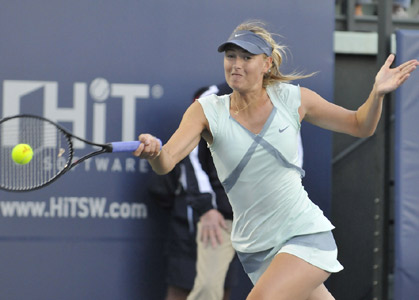C330F12E-DF4B-4C2A-8A0B-5044CC30EDE6

By Kait O'Callahan
© Tony Chang/Chang Photography
(August 5, 2010) This month I was struck with more inspiration than the clay and grass seasons combined had given me. Unfortunately, my sudden urge to write wasn't due to a brilliant piece on a new upcoming star I hadn't heard of, and neither was it a well-written rebuke of one of my favorites. Instead what had me fired up was yet another narrow-minded article on why female tennis players should not be paid the same as their male counterparts.
The author's view was that women do not bring the same amount of revenue to the Grand Slams and so they shouldn’t be paid the same. In one way I have to credit his originality, most arguments center around women not having to play the best of five sets. Yet at the same time I would have almost preferred to read more of the same old in favor of this uninformed piece.
The author managed to back his argument up with almost no evidence that men draw more revenue than women, but it is of course an undeniable fact that men's tennis attracts more attention than women's and therefore more money. The big question that nobody seems to ask is why? It may not be as simple as, "they hit the ball harder and move better", yet there seems to have been little investigation into the topic outside of gender-studies lecture theaters.
One answer may come in the form of media coverage. The majority of countries give more television and newspaper coverage to men's tennis over women's. Grand Slams give the false impression of equal coverage between the sexes as they do tend to cover women's tennis just as much as the men's and are more likely to put the bias on country of origin. However, between the Slams where the seeds are discovered and a fan will grow their passion for the game, equal television coverage is a different story.
Australia's Foxtel network is a classic example. Despite Australia's best player being Sam Stosur, Australia places more attention on men's tennis outside of the Slams. From July 22nd to August 20th of this year, Fox Sports are scheduled to show a mix of live tennis and replays 53 times. This is a substantial number in a month that isn't jam-packed with top events and Foxtel must be congratulated for this. What is disappointing however is that women's tennis is only scheduled 12 times, that makes up an underwhelming 23% of tennis air-time. This isn't due to a lack of women's tennis on over the four weeks. There are six WTA events during this time, four of which are Premier events. The men are also playing six events; two are Masters and one is a 500. Clearly the level of tennis is similar for both the WTA and ATP, so why is it that the WTA are not broadcast anywhere near as much?
This time period is not an exception to the rest of the year either, Fox Sports broadcast every single Masters Series event in full but only cover some of the Premier events. WTA fans can hope for some extra coverage on the Asia/Pacific Eurosport channel, but their coverage is fairly minimal. ATP fans have it much easier; they are guaranteed all the big tournaments and many of the smaller ones on Foxtel's main sports channels. If that falls through, Eurosport also cover some of the ATP. The coverage is clearly skewed in favor of the men.
Britain seem to cover even less WTA than Australia. Sky Sports don't show any WTA but have extensive coverage of ATP. WTA fans have to rely on Eurosport, which is an international channel.
In the USA the situation is much better. Between ESPN and the Tennis Channel both tours are covered almost equally over the US Open Series. ESPN skewers their coverage in favour of the men by 62% but the Tennis Channel balances this by favoring the women’s side by 66%. They are both showing roughly the same amount of tennis. Subscribers of both channels would have equal access to both tours over the current US Open Series. The downfall is that the main sports channel, ESPN, is the one favoring the men. The Tennis Channel requires a separate subscription and is likely to attract only established tennis fans. This creates a problem with the WTA trying to target newcomers to tennis when they only receive a third of the air-time on the more popular ESPN. As a result, new fans of tennis are more likely to be familiar with the ATP.
Keen to dig even further, I conducted a survey on the popular Live Journal forum ‘Oh No They Didn’t Tennis’. By asking three simple questions, it was found that 60% of respondents felt that women's tennis was given less coverage than men's overall. A further 67% stated they would like to see more women's tennis broadcast, while an overwhelming 75% thought that more coverage may help interest in women's tennis grow. This survey was taken from a mix of nationalities and therefore respondents had access to a range of international television channels, magazines, and newspapers. There was a general consensus that whilst there is a relatively equal focus on both sexes throughout Grand Slams, outside of the Slams the men garnered more media coverage than the women.

The interest in women's tennis that is evident online is also evident inside the world of sponsorship deals and magazine covers. Tennis is the most watched women's sport and its big names are amongst the worlds most famous. Maria Sharapova signed a deal with Nike that reportedly exceeds both Roger Federer's and Rafael Nadal's pacts with the Oregon-based company. Clearly Nike have no problem gaining revenue by marketing Sharapova's image. Serena Williams is another female who has found just as much fame as the top men; in 2010 she was the only tennis player, male or female, to find herself ranked on Time Magazine's "100 Most Influential People" list. Clearly it is not a lack of marketability or public interest in women's tennis that results in a lack of media interest and television coverage.
With a little bit of research it becomes clear that women are not given the same opportunities as men to generate equal revenue. This isn't because they are unpopular or unmarketable, it is because the media do not understand that there is an audience for women's tennis and that it could potentially grow to be just as popular and profitable as the men's. We will never know until the WTA is treated the same as the ATP. Equal pay is a step towards giving female tennis players the respect they deserve. Of course, equal pay in tennis is largely just a myth.
Female tennis players are paid nowhere near the amount men are. Instead they are paid the same amount just five times a year, at the four Slams and Miami. A quick comparison between players ranked outside the top fifty proves that women's prize money is far below men's across the board. The world number sixties, Kimiko Date Krumm and Jarkko Nieminen differ in prize money by almost $2.4 million in favor of Nieminen. It's a similar story with the world number seventies, Sybille Bammer and Andreas Seppi, with Seppi leading by $467,000. Looking down further even world number eighty, Andreas Beck, has made $438,793 more than his female counterpart Romina Oprandi. This occurs because the WTA simply cannot pay the same amount of prize money as the ATP as they don't generate as much revenue.
For all those losing sleep thinking that Slams are struggling financially because of equal pay, you can take solace in the fact that the difference is negligible. The difference between women's prize money in the last year of unequal pay, 2006, and the first year of equal pay, 2007, cost Wimbledon ₤600,000. The difference was covered by the estimated ₤26-27 million the club generated in revenue in 2007, according to a New York Times report. It's reasonable to assume similar figures apply at the other Slams. The change is simply cosmetic.
The argument that women don't deserve equal pay because they don't create equal revenue falls flat when presented with the research that proves women are not given the same opportunities to gain equal revenue to the men. In order to generate equal revenue, women's tennis needs to be treated equally to men's.
Equality does not just mean equal pay. Equality means equal television coverage, equal attention in newspapers, magazines, and above all, equal respect. This means not scheduling the defending champion and World No. 1 Serena Williams on Court Two at Wimbledon. This means giving the public a chance to follow their favorite female players outside of the Slams and newcomers to find a female as their first favorite. It means recognizing that women's tennis can be just as good as the men’s and yet understand that they are different. Equal pay at Slams is a step in the right direction. This way lies the future.
New Zealand native Kait O'Callahan is a Tennis Now contributing writer based in Australia. Please visit her website Any Given Surface.